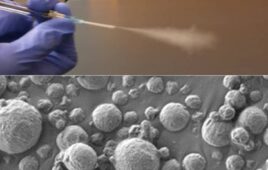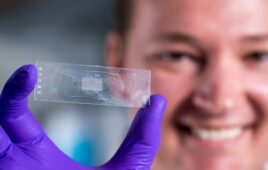
Illustration of sepsis biomarker stuck in nanohole. (Image from Ecole Polytechnique Fédérale De Lausanne)
Researchers in Switzerland have developed an optical biosensor that they say slashes the time it takes to diagnose sepsis from several days to just a few minutes.
Their novel approach draws on recent developments in nanotechnology and on light effects at a nano scale to create a highly portable, easy-to-use device that can rapidly detect sepsis biomarkers in a patient’s bloodstream.
Sepsis is the primary cause of death in hospitals, and one of the 10 leading causes of death worldwide. It is associated with the body’s inflammatory response to a bacterial infection and progresses extremely rapidly: every hour that goes by before it is properly diagnosed and treated increases the mortality rate by nearly 8%.
Researchers at the Laboratory of Bionanophotonic Systems (BIOS) at Ecole Polytechnique Fédérale De Lausanne‘s School of Engineering developed the biosensor. Because it uses a unique plasmonics technology, it can be built from small, inexpensive components, yet the researchers say it can achieve an accuracy on par with gold-standard laboratory methods.
The device can screen a large panel of biomarkers and be adapted for the rapid diagnosis of a number of diseases. It was installed at Vall d’Hebron University Hospital in Spain and used in blind tests to examine patient samples from the hospital’s sepsis bank. The researchers’ technology is patent-pending, and their findings were recently published in the journal Small.
The device employs an optical metasurface — in this case, a thin gold sheet containing arrays of billions of nanoholes. The metasurface concentrates light around the nanoholes to allow for exceptionally precise biomarker detection. With this type of metasurface, the researchers can detect sepsis biomarkers in a blood sample with nothing more than a simple LED and a standard CMOS camera.
The researchers begin by adding a solution of special nanoparticles to the sample that are designed to capture the biomarkers. They then distribute this mixture on the metasurface. Any nanoparticles that contain captured biomarkers are trapped quickly by antibodies on the nanoholes, according to lead author Alexander Belushkin. When an LED is applied, those nanoparticles partially obstruct the light passing through the perforated metasurface.
“These nano-scale interactions are imaged by the CMOS camera and digitally counted in real-time at high precision,” said co-author Filiz Yesilkoy in a news release.
The generated images are used to rapidly determine whether disease biomarkers are present in a sample and, if so, in what concentration. The researchers used the new device to measure the blood serum levels of two important sepsis relevant biomarkers, procalcitonin and C-reactive protein.
“We believe our low-cost, compact biosensor would be a valuable piece of equipment in ambulances and certain hospital wards,” said Hatice Altug, the head of BIOS.




